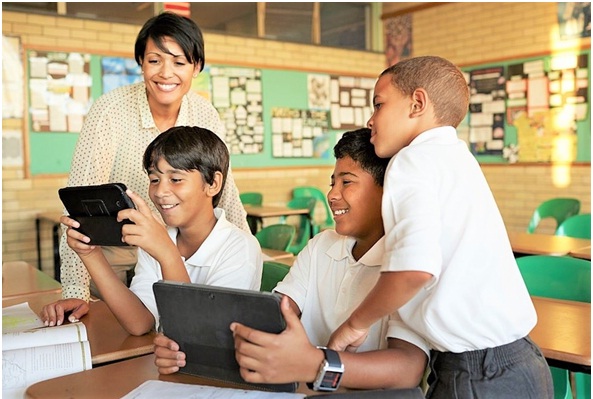
For a skilled teaching professional, the access to new digital learning models and developing the 21st-century skills every student need is very crucial. Also, the year 2020 immensely has changed the way of teaching-learning practices. However, the concept of digital learning communication is not a new thing for us. The contemporary e-learning models not only enhance the teaching-learning knowledge, but also call center training manual examples pave the way for becoming effective digital citizens.The same case goes with the K-8 classroom also, therefore,teachers of the K-8 classrooms have to be prepared to develop their own digital literacy skills.
K-8 schools, elementary-middle schools, or K-8 centres are kinds of schools that basically enrol kids from kindergarten/pre-K to 8th grade. Forming a successful virtual learning/e-learning/digital learning experience for learners is not an easy task to do. Therefore, pre-primary teacher training course programs are emphasizing on the urgent need for expanding the understanding of digital literacies.
But… what makes a digitally sound classroom?
Is it the teacher?Orcan a video conference with learners coming together to study can be measured as a digital classroom?
Is it the digital tools that can be calculated?
Well, these are some of the things that we have to ponder about. Henceforth, we have tried to point out 5 important elements of a digitally sound classroom for you.
The Spaces
The first and foremost element of our discussion is “space”. Your classroom should not only be furnished with digital devices or gadgets. Make sure there are enough spaces for other classroom activities as well. The spaces in a digital classroom can be modified, still or secure, open or closed, approachable or mute. Your classroom should ideally be 1:1, means 1 computer/laptop for each student. Through this way, your learners would be more involved and interested to learn. A 21st-century digital classroom should also need to have some space for physical activities too. These kinds of classrooms have the potential to make learning completely individual for each learner, at the same time connect with other peers as well.

Technology
Next comes the technology part. It is the most vital part of any kind of digital learning spaces. It includes Wi-Fi, hardware or software, operating systems or the kinds of digital media platforms that incorporate the technology. It is universal and therefore,is very important. Also, the social media platforms like Facebook, Instagram, YouTube channel etc.are important.Some more examples include- Apps, wearable technology, games, artificial intelligence, kindles, cloud storage and file-sharing, smart boards, podcasting tools and so on.
The Data
Well, it is very imperative for giving valuable feedback in a digital environment, especially for e-learning in the K-8 Classroom. The data can be stockpiled or shared through the various learning models and can be modified or custom-made as per the requirement of each learner. For example, your students’ interests and background knowledge, reading level changes, assessment performance, evaluating student behaviour, etc. all of these things fall under data.
The Tone
One of the obviousstructures of a digitally sound classroom is its tone or quality. Starting from the workflow of educators to at which speedthe assignments are being given, and so on. Also, the digital schoolroom makes it easier to put pupil’sdevelopment on display.However, the classroom management has been a challenge in this kind of setup.Therefore, teachers have to adapt the online classroom management strategies as well. For example, by the tone we meant occasionally demanding learners sign up for an account before completing an assignment, asking a student to complete an assignment so that they may open a new account and so on.
Workflow
Well, in a digital classroom, the workflow generally shifts from teacher to student to the student to everything else then student and then everything else. The workflow in a digital schoolroom delivers additional prospects for creative response, critical assessment, trustworthy contexts, psychological care, etc.

For better understanding, let’s take an example: Generally, in a traditional teaching space, the workflow is equitablylikely: a teacher gives an assignment, the students complete the assignment and return to the teacher. Though sometimes, teamwork between students happens here. Sometimes, teachers may send the work back to the learner with learning feedback, then ask the student to submit again. While in a digitally sound classroom, the workflow can be similarly twofold – from learners to learning platform where a scholarfinishes a lesson, or maybe a student submits an essay assignment via Google Drive to a teacher.
Feedback Circles
In the digital learning space, the game-based learning projects allow an instant feedback for the educators and students as well. These platforms let apprentices know if the answer is correct or not instantly. The feedback loops or circles are much quicker in a digital classroom than in a traditional one, it can be modified—per student, per lesson, per individual or group work, etc.
Prospects or Opportunities
Well, the basic idea behind this is that as students are learning in digital spaces, they are more able to create new things, collaborations, platforms, etc., which then produces uncountable new opportunities for them out of the classroom. These can be anything like evolving a project that plants trees in city areas, discovering a new hobby, realizing new art/music/literature, etc.

(Ref: https://bit.ly/3riUr0G)
Post-Covid classroom structure
Resolution & Onlookers
Basically, the resolution or the purpose of digital schooling is to abstract the spirit of contemporary education at its best possible way. In a digital classroom, purpose and onlookers are the most powerful swings as experienced by the undergraduates. By the onlookers we meant who is this classroom ‘for’?More acutely, who can we connect learners with to help them?Who can help them grow? The purpose and audience of a digital teaching space can become almost anything with great transparency and association.
Conclusively we can say a transformation is required to advance the mentality to acquire and seek wisdom to create new ideas with a different perspective for digital learning communication in K-8 classrooms. The teacher training courses also developing the teaching professions by keeping all these elements in mind so that they can nurture the upcoming generation well.
Building a successful digitally sound learning culture takes time, start small and shape as you go!



